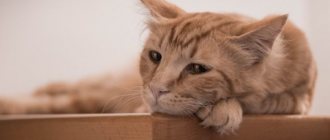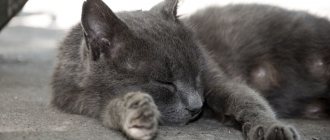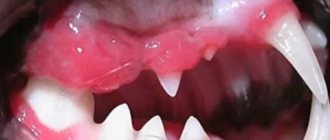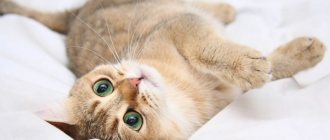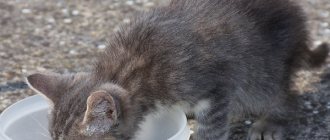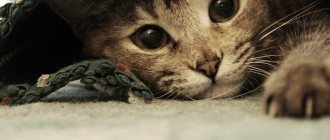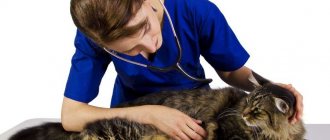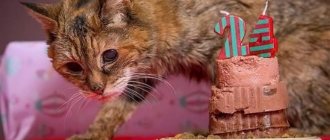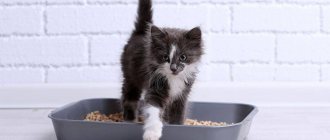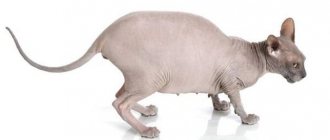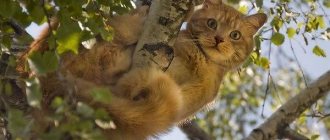Intestinal obstruction
- this is a complete or partial cessation of the movement of contents through the intestines. The most common cause is foreign body blockage. This is followed by blockage as a result of a tumor, volvulus, hernia or intussusception (penetration of one part of the intestine into another), etc.
Mechanical blockage with a foreign body reveals itself suddenly, out of the blue. How this happened a few days ago with my cat Avatar. Who is the cat Avatar and what is special about him - see here, it will be interesting.
Avatar During the day, vomiting suddenly began. At first I didn’t attach any importance to this. Well, I vomited once, who doesn’t? Again. Already alarmed. And I got really worried when the cat flatly refused to eat, without even looking towards the bowl. To test, she offered an impossible delicacy - a piece of chicken. Decisive refusal. Everything is bad!
Vomiting continued at night. And the next morning we were already at the clinic. They immediately took blood for analysis and put me on a drip without talking. Why?
Causes of the phenomenon
Intestinal obstruction can occur in both adult cats and kittens. The following unfavorable factors can provoke the appearance of the disease:
- The occurrence of intestinal paralysis. It is a consequence of injuries to the spine and gastrointestinal tract, diseases of the nervous system. In this case, there is a lack of peristalsis. Treatment will be long and difficult, since the root cause will first need to be eliminated.
- Foreign object. In the vast majority of cases, intestinal blockage occurs when objects that cannot be digested enter the organ. They close the lumen and interfere with the passage of feces. This phenomenon often occurs in long-haired cats when hairballs accumulate in the intestines.
- Helminthic infestations. If there are a large number of parasites in the intestine, it becomes blocked, as the worms stick to the walls of the organ and interfere with the movement of feces. This reason is more typical for kittens, since their intestines are very small. An anthelmintic in this case is not a way out of the situation, since a large number of dead parasites will create a congestion in the intestines and lead to a deterioration in the cat’s condition.
- Volvulus. As a result of the incorrect position of the intestines, when one pulls on the other, forming loops, the normal passage of feces through the organ is disrupted. This cause of obstruction is especially dangerous: the area of the compressed intestine ceases to be supplied with blood and gradually dies. A decomposition process begins inside the animal, causing severe intoxication.
- Tumors and other neoplasms. They can partially or completely block the intestinal lumen and are often malignant.
- Constipation. If the animal’s diet is not balanced, or there is a lack of drinking water, then the feces become dry and hard, and a plug forms in the intestines. Processed food is not eliminated from the body naturally, and signs of intoxication increase.
Sometimes pet owners think that a laxative will help solve the problem. This is wrong. In most cases, it will cause even more harm and can hasten the death of your pet. Only a veterinarian knows what to do if a cat has an intestinal obstruction, so your pet needs to be shown to him as soon as possible.
Why is obstruction dangerous?
- A cat's intestines are constantly working, pushing contents from the stomach to the anus. At the same time, the circulation of an important nutrient fluid continuously occurs: digestive juices produced by the stomach and intestines, during the work of the intestines, along with dissolved nutrients, penetrate through the walls back into the intestine.
When a blockage occurs, juices continue to be released, but now, unable to move and be absorbed, they accumulate in the stomach and small intestine, causing vomiting. With vomiting, a large amount of fluid and nutrients (especially potassium) is lost, rapid dehydration and weakening of the body occurs.
Drinking water does not help, but only makes vomiting worse. Without treatment within 2-7 days the animal will die.
Therefore, in case of serious disturbances in the functioning of the gastrointestinal tract (especially in case of obstruction!), abundant intravenous infusions are needed to replenish fluid.
- In addition, at the site of blockage, due to poor circulation in the affected area, necrosis may occur - tissue death of the intestinal wall, which will develop rapidly, which will also worsen the condition of the animal.
- And further. It happens that the presence of a foreign body in the intestines leads to its decomposition, oxidation, etc. and the release of toxic substances from it, which contributes to additional intoxication of the body.
- Obstruction (as well as chronic constipation) provokes the proliferation of putrefactive and other harmful bacteria, which leads to serious disruption of the intestinal microflora.
The closer the blockage is to the stomach, that is, the larger part of the intestine is closed, the more severe the disease.
Causes
Intestinal obstruction in cats occurs for the following reasons::
- A foreign object in the intestine that has blocked the intestinal lumen . This reason is noted in 80% of cases. In long-haired breeds, the problem may arise due to the constant ingestion of their hair, which, without being eliminated from the body, forms a ball that clogs the upper gastrointestinal tract. Also, a cat can swallow something that leads to intestinal problems and is not naturally eliminated from the body on its own. Treatment by a specialist is necessary.
- Worms . Both living and dead parasites pose a danger, since in excessive quantities they form lumps that completely block the intestines. If the worms die from it after using the drug, they will begin to decompose in the intestines, causing additional severe poisoning of the cat.
- Long-term constipation . In such a situation, feces become excessively dry and, remaining in the intestines, form a plug, which leads to complete obstruction. It closes the intestines, which prevents the food processed in the stomach from moving further. Feed decomposes while in the stomach, and their breakdown products poison the cat’s body. Intestinal obstruction of this nature in cats most often occurs due to improper nutrition.
- Volvulus in a cat . It occurs due to constriction, which disrupts blood circulation in a certain area of the intestine. Because of this, it slowly dies and begins to decompose. Treatment is urgent.
- Intussusception in a cat is the insertion of one part of the intestine into another. It is the next type of bloat and has the same consequences. Treatment cannot be delayed.
- Tumors in the intestines . Growing inside the intestinal lumen, they initially provoke a partial blockage, which gradually worsens and, if no treatment is taken, turns into complete obstruction. The cat most often dies not from it, but from a neoplasm.
- Intestinal paralysis . It can occur for many reasons, from diseases of the nervous system to injuries to the intestines and spine. In this case, the cat's intestinal blockage is severe. The treatment is complex.
Whatever the cause, it is imperative to treat obstruction in a cat, since the condition of this pathology is serious, and the animal requires urgent veterinary care.
© shutterstock
Symptoms of obstruction
- increasing vomiting
- loss of appetite to the point of complete refusal to eat
- no or little stool
- deterioration of general condition
- painful enlarged belly
What to do? At the slightest suspicion of an obstruction (especially if you know that your pet had the opportunity to eat something “wrong”) - run to the clinic!
What not to do? Do not try to feed or water the cat - this will only provoke vomiting. Do not give an enema, as this may cause intestinal rupture. Do not give a laxative that increases contraction of the intestinal muscles. Do not use antiemetic drugs, which will only mask the symptoms without providing a therapeutic effect.
Treatment
A cat with intestinal obstruction should only be treated at a veterinary clinic. No home self-medication, herbs, massages, etc. It’s one thing when a cat has coprostasis (constipation) or flatulence (a lot of gas accumulates in the intestines). But if a cat has an obstruction, then you need to figure out the cause first.
- If the ileus is mechanical, then surgical intervention will be required. This is the fastest and safest way to save an animal. The use of a laxative can lead to intestinal rupture, peritonitis and, as a result, the death of a beloved four-legged family member.
- If coprostasis has led to the fact that the cat cannot poop (although the first day there may be loose stools, the body seems to be trying to “wash out” the foreign body from the intestines), then the veterinarian will do an enema, first put a drip with saline solution or inject it subcutaneously (so that there was no dehydration). But before this, the doctor must make sure that the enema will not harm the animal and will not lead to intestinal rupture! To do this, several additional examinations should be carried out (ultrasound, x-ray)
Giving Vaseline oil is effective. The animal's diet includes wet food and more fiber (vegetables). But this can only happen if the patency is impaired due to dry feces. But for other reasons of obstruction it is contraindicated!
After removing the foreign object from the digestive tract, the animal can be prescribed anti-inflammatory, antibacterial and even painkillers.
Don't delay treatment! Without it, the animal can die within a week! Sometimes death is registered already on the second day after the appearance of the first symptoms!
About Vaseline oil
Vaseline oil is a purified fraction of petroleum without harmful organic substances and their compounds, mixes with fats and oils and has the properties of petroleum jelly. Without being absorbed into the walls of the gastrointestinal tract, it envelops the obstacle in the form of feces, softens them and facilitates the process of pushing. Indication: constipation. Contraindication: intestinal obstruction.
Here we come to a difficult dilemma: constipation or obstruction? With constipation, accumulation and hardening of stool usually occurs in the middle and lower intestines. And Vaseline oil is your first friend here. It can also help with partial obstruction.
In case of complete obstruction, the oil will aggravate the situation, becoming an additional burden in the gastrointestinal tract. In addition, it can “drag through” a foreign object a little, damaging the intestinal walls and causing their necrosis.
Thus, giving a cat Vaseline oil when there is a blockage is a risk: it may solve the problem, or it may worsen the situation.
Symptomatic manifestations
Symptoms of intestinal obstruction are pronounced and in cats can be as follows:
- The animal's mood changes dramatically. Some owners note apathy, a desire to hide from people and other pets. In another case, the cat will try in every possible way to attract attention to itself: meow loudly, follow behind, show its belly. Any changes in the cat’s usual behavior are an alarming symptom.
- The pet refuses to eat. At first, the amount of food consumed becomes less, then a complete refusal of food occurs.
- With partial intestinal obstruction, cats begin to vomit after eating. This symptom indicates that only a small amount of food was able to move through the intestines. The remaining food causes unbearable stomach pain in the animal, so the pet reflexively burps.
- No bowel movement. This symptom of intestinal obstruction in cats cannot always be considered reliable in individuals who often walk outside. In this case, it is almost impossible for the owners to track where exactly the cat emptied its bowels. Pets are another matter. A prolonged absence of feces in the tray can be a sign of either ordinary constipation or intussusception in a cat or kitten.
- Aggression when attempting to inspect. If the owner tries to feel the pet's belly, the cat is likely to bite or scratch. This is due to the fact that the animal experiences severe pain, and touching only aggravates the situation. If the cat allows itself to be examined, the owner will notice tension in the walls of the abdominal cavity, and sometimes he will be able to feel a foreign object or a hard area in the intestine. It is better not to carry out an examination unless absolutely necessary, since a careless movement can harm your pet.
- Abdominal enlargement. Since the gases accumulating in the intestines have no outlet, the pet’s abdominal cavity begins to increase in size. You may notice that the cat is rolling on the floor and actively licking its belly.
If an animal exhibits at least one of the symptoms described above, this may indicate intestinal obstruction in cats. The best decision that the owner of a sick pet will make is to immediately show it to the veterinarian, since trying to give a laxative, warming up or massage will only bring harm.
Partial obstruction
With incomplete obstruction, part of the intestinal contents can pass through the obstruction, but with complete obstruction, not. With partial blockage, the animal can survive, while complete blockage poses a mortal danger.
Avatar Two years ago, with the same Avatar (oh, poor cat!) we experienced partial obstruction. Avatar opened the cabinet under the kitchen sink and gutted the trash can. For more than two weeks (!) the cat was lethargic, ate a little and only soft food, there was stool, but very scanty. An X-ray with contrast did not give an accurate result (50x50 - it seems like there is an obstacle, but the contrast agent seems to pass through it). I was given intravenous drips every day. The doctors were inclined to operate.
Deciding that there was nothing to lose anyway, I literally pumped the cat up with Vaseline oil (I had done this before, but not so decisively - there was no result). And Avatar finally produced such a bunch of sausage skins that it was impossible to imagine how it all fit in a small intestine, lay there for two weeks, and the cat lived with it! But imagine my amazement when the next day another similar pile came out. Just unbelieveble! Since then, we have kept the trash can under safe lock and key.
Prevention
Treating intestinal obstruction in a cat is a complex process that requires surgery in most cases. However, knowing about preventive measures, you can effectively protect your cat from the problem. To prevent pathology it is recommended :
- proper natural nutrition, dry food and constant availability of water for the cat;
- do not use small objects that can be easily swallowed for playing with the cat;
- feeding cats with preparations to remove hair from the body not only during the molting period, but also for prevention once a week.
It is important to monitor the condition of your pet and, if necessary, promptly show it to a veterinarian for high-quality and complete treatment. In the case of intestinal obstruction, time is of the essence.
Intestinal obstruction is one of the most common diseases in cats, and its symptoms are pronounced. The disease is often confused with constipation, so they do not show the animal to a veterinarian, but try to cure it on their own, causing even greater damage to the pet’s health.
The cause of the disease in cats can be volvulus, swallowed foreign objects, gastrointestinal diseases, but in any case the symptoms will be pronounced. Depending on the factors that triggered the onset of the disease, treatment can be either conservative or surgical.
Diagnosis of obstruction
With symptoms of acute obstruction, this dangerous disease is always ruled out first.
The diagnosis is made based on clinical symptoms and examination by a doctor. Careful palpation will determine the “acute abdomen” and painful area. Blood tests are needed to assess the cat's condition and identify concomitant diseases. If obstruction is suspected, an x-ray of the abdominal cavity, for better information, with a contrast agent.
If all these studies do not make it possible to make an accurate diagnosis, what remains is diagnostic laparotomy (as they say, “an autopsy will show”) - an incision in the abdominal cavity - a surgical operation under general anesthesia, which will reveal the pathology.
Avatar So, while we were dripping (2 hours, no less), the test results became ready. Everything is normal, with minor deviations that can be attributed to vomiting and hunger strike. A thorough examination by the doctor and palpation revealed a painful area in the abdomen. In general, the dire diagnosis of obstruction is becoming more and more clear. We go for an x-ray, having previously pumped ourselves up (20 ml) with a contrast agent.
Why is a contrast agent needed? In the animal's body, along with bone tissue, which gives a clear shadow picture during radiography, there is also soft tissue that creates a less dense shadow. Therefore, if tissues and organs are approximately the same in density, then their boundaries are difficult to distinguish on an x-ray. This also applies to the abdominal organs - liver, stomach, intestines, etc. How can we discern changes in them? For this purpose, substances with high atomic weight are used, creating a difference in density between the desired organ and the rest of the environment.
Barium sulfate is often used as a contrast agent for examining the gastrointestinal tract. It is a chemically pure, harmless, insoluble white powder, odorless and tasteless.
Avatar In the process of feeding the cat with a cocktail of water and barium, everything was smeared - the table, chair, floor, carrier, me, the doctor and, finally, the cat itself. It’s good that dried barium is easily cleaned like chalk.
Let's take a photo. And two things immediately become clear. Firstly, the cat was given barium in vain, because, secondly, even without contrast it is clearly visible that in the Avatar’s stomach lies... a metal clamp holding the skin on the end of the sausage. A week before Avatar, the Sphynx Ramses was in the clinic with symptoms of obstruction, from whom, as a result of an operation, the same end of the sausage was removed, and the doctors confidently identified its analogue in the picture of my cat. Here's a photo. The barium-filled stomach is clearly visible, followed by a wire curl:
Of course, no one deliberately gave him a dangerous “yummy.” It was just unwise to leave it on the table. The avatar himself cannot get anything from the table, but he has four-legged friends who helped him.
What to do? After consulting, we decide with the doctors to give Vaseline oil a chance, considering that it may work for my cat. Once again we drip for a long time, drink the oil and go home.
At home, the Avatar's condition worsens. He literally howls and starts vomiting again. My stomach is so bloated that I understand that Vaseline oil is not an option. After a disturbing night, we are at the clinic early in the morning. We dig in again and go to the operation.
International Veterinary Center for Reproduction and Artificial Insemination of Small Animals
CLINICAL CASE – FOREIGN BODY OF THE SMALL INTESTINE IN A CAT Perepechaev K.A. Ph.D., Menshenina E.S.
2012
Disease history:
A 1.5 year old, sterilized, outbred cat was admitted.
Contents: home, apartment.
Vaccination: comprehensive + rabies.
Feeding: ready-made food (Pro Plan).
Complaints:
According to the owners, 7-10 days ago the cat chewed a soft rubber toy. For 24 hours after this, the cat was lethargic and refused to eat. The next day there were 2-3 bouts of vomiting. Small pieces of rubber came out with the vomit. After this, the cat’s condition returned to normal, and her appetite and physical activity were restored. 36 hours ago, the cat began to vomit frequently saliva and bile (5-6 times a day). The animal refused to eat. The owners took an x-ray at the veterinary clinic closest to their place of residence and brought the cat to our center 24 hours ago.
Diagnostics:
General condition: satisfactory, no signs of dehydration or intoxication, lethargy, drowsiness, temperature (rect) 38.9o C.
According to the X-ray results: there are no obvious signs of a foreign body, there are areas of compaction in the area of the stomach and small intestine, and there is an accumulation of gases in the intestines.
According to the results of ultrasound of the abdominal organs: gas formation in the stomach; abnormal peristaltic “pendulum” movements in the small intestine are a sign of a foreign body.
On palpation: the abdomen is soft, the intestines are collapsed. When pressing in the area of the stomach and small intestine, the animal experiences some discomfort.
According to the results of blood tests: General clinical blood test – normal; Biochemical analysis - increased concentration of liver enzymes (ALT, AST).
Differential diagnosis: post-traumatic gastroenteritis or foreign body of the stomach or small intestine.
Healing procedures:
After placing an intravenous catheter, intensive infusion therapy (administration of plasma replacement solutions, antibiotics, analgesics, etc.) was carried out for 1.5 hours. A starvation diet was prescribed. Water intake is allowed (fractionally). Despite the therapy and improvement in general condition, the cat continued to vomit, even after drinking liquid. The vomiting continued at night and in the morning. With the consent of the owners, it was decided to carry out therapeutic and diagnostic surgery under general anesthesia. As a result of diagnostic laparotomy, a foreign body was discovered in the cat's duodenum. The wall of the duodenum is edematous, hyperemic, without signs of necrosis or perforation (Fig. 1).
Figure 1. Section of the duodenum with a foreign body.
A small incision was made in the intestine and the foreign body was removed. In appearance, it is a piece of soft thin rubber, partially digested, hollow inside, cap-shaped, measuring (approximately) 3.0 x 1.5 cm (Fig. 2).
Figure 2. Appearance of a removed foreign body.
The operation was completed without complications (Fig. 3).
Figure 3. Operation completed. Appearance of the postoperative suture.
The postoperative period (14 days) passed without complications. Normal independent intake of water on the 2nd day, food intake on the 3rd day after surgery. The sutures from the skin of the abdomen were removed on day 14, and the cat’s complete clinical recovery was stated (Fig. 4).
Figure 4. Satisfied cat 1 month after surgery.
Comments from the attending physician:
Unfortunately, cases of cats chewing and swallowing small rubber products (toys, bottle caps, suction cups, etc.) are not uncommon. Immediately after swallowing, foreign bodies irritate the gastric mucosa and provoke vomiting, which is sometimes partially expelled. BUT, larger pieces of rubber often remain in the stomach and do not bother the animal for some time (sometimes up to several days). After a certain time, a piece of rubber, partially digested and softened by gastric juice, begins to move into the small intestine, and since the small intestine has a much smaller diameter than the stomach, it immediately becomes clogged. I think that's exactly what happened with our cat.
Immediately after the duodenum is blocked, vomiting begins, and from that moment on, success in saving the animal’s life depends on the speed and correctness of the chosen tactics. The fact is that increasing intoxication and dehydration very quickly depletes the animal’s strength. Since foreign bodies made of polymeric materials are often very poorly visible on X-rays, and the animal still feels quite well in the first days, owners and doctors sometimes waste time trying to solve the situation with the help of therapeutic interventions, even if it does not have an effect. Diagnosis of so-called “soft, radiolucent” foreign bodies is always very difficult. In some cases, the only reliable way to make a definitive diagnosis is to perform an exploratory laparotomy (literally, “cut and see”). Unfortunately, very often the decision to perform an operation is made too late, when intestinal perforation has already occurred, peritonitis has developed and the animal is in a state of severe intoxication, dehydration and exhaustion. In such cases, the chances of saving the patient tend to zero.
In our case, as soon as it became clear that intensive therapy was not producing results, a decision was made IMMEDIATELY to conduct a diagnostic intervention, which gave immediate results. The high professional level of our surgeons, a competent approach to anesthesia, intensive care and rehabilitation, the presence of our own laboratory and the ability to immediately and accurately carry out any necessary tests, reduces the risk of planned surgical interventions to a minimum and ensures high-quality, fast and safe performance of complex abdominal operations.
Good luck to you and your four-legged pets! Do not be ill!
| Perepechaev Konstantin Andreevich veterinary ophthalmologist, microsurgeon, Ph.D. tel.: 8-926-523-18-97 website: https://9265231897.ru |
The authorship of this article is protected by the Copyright Law. Any copying of materials without indicating the author and a link to the original source “International Veterinary Center for Reproduction and Artificial Insemination of Small Animals” is prohibited
Similar materials
- CATARACTS IN CATS. DIAGNOSIS AND TREATMENT.
- Reproductive problems in cats
- Chronic viral infections of cats
- Calendar of expected births in cats.
- Life before birth: cats.
Treatment of obstruction
Treatment begins immediately, even before diagnosis. This includes infusion therapy (droppers) to replenish the loss of water and nutrients, painkillers and anti-inflammatory drugs, and antibiotics.
In severe cases, when intestinal blockage threatens the life of the animal, emergency surgery is indicated. Sometimes this involves removing the affected part of the intestine.
The postoperative period includes a fasting diet for 12-24 (sometimes more) hours, again intravenous drips, and antibiotics. Next - careful feeding with semi-liquid food. For 14 days it is necessary to monitor the condition of the sutures, which are then removed.
Avatar Avatar now has a “colleague” in the operation - a calico cat Monya, whose x-ray shows... the same foreign body as his. Ha-Ha! They go under the knife one after another.
I photographed the trophies after they were removed. Here they are. Avatarkin is on the left, Moni is on the right. Apparently, the sausage brace is a hit among foreign bodies in cats
The operation was successful, the sausage element was removed, there was no necrosis of the intestinal tissue - only two reddish dots from the metal pressure (that's what it means to react in time!). The avatar is resting. He was kept in hospital overnight. After recovering from anesthesia, he was prescribed an enema (a lot of feces had accumulated) and, of course, an IV.
Avatar, unlike other cats who have undergone surgery, does not need a post-op blanket because he cannot lick his belly. And a sick antibiotic can be given to him in the back muscle - there is no deep sensitivity. At least there are some advantages to paralysis.
The next day after the operation, the cat feels well, is active, moves his head, is interested in everything - cannot be compared with his recent state, when he was lethargic and apathetic. Morning and evening - endless droppers. Finally, after grabbing an infusion solution and an antibiotic, we go home. Hooray!
At home, the cat behaves as if there was no serious surgery. Let's dig on our own. How easy it is for doctors, and how difficult it is for a layman! We cope with sin in half.
I carefully begin to feed her with Royal Canin Recovery pate (1-2 teaspoons every 2-3 hours). The appetite is excellent. The whole family breathed a sigh of relief. We rejoice. But in vain!
By the evening of the next day - complete refusal of food. In the morning we go to the clinic again. We donate blood and sit down to take a bath. The tests are normal, the treatment is drips, drips and more drips. The antibiotic continues in a continuous course. By evening the cat begins to eat.
At home now. We continue IVs, antibiotics, soft nutrition. The avatar feels great and is already chasing cats. True, he’s still weak, he rests a lot, but that’s normal. The seam is fine, although slightly dented. It looks like the obstruction story is coming to an end. Pah-pah-pah...
Do you think she will teach the Avatar something and he will learn some lesson? No matter how it is! If someone drew conclusions, it was not the victim, but his owners, that is, us.
Clinical case of treatment of intestinal obstruction in a cat
The cat Izyum was admitted to the Pride Veterinary Center with complaints of repeated vomiting with blood and refusal to feed for three days.
During an examination by veterinary therapist A. M. Vasilyeva, a thread was discovered under the tongue. After X-ray diagnostics with contrast, a diagnosis of intestinal obstruction was made. Surgeon A.K. Mamedkuliev performed surgery and the thread was completely removed.
At the moment, Izyum’s condition is excellent, he is undergoing treatment at home.
